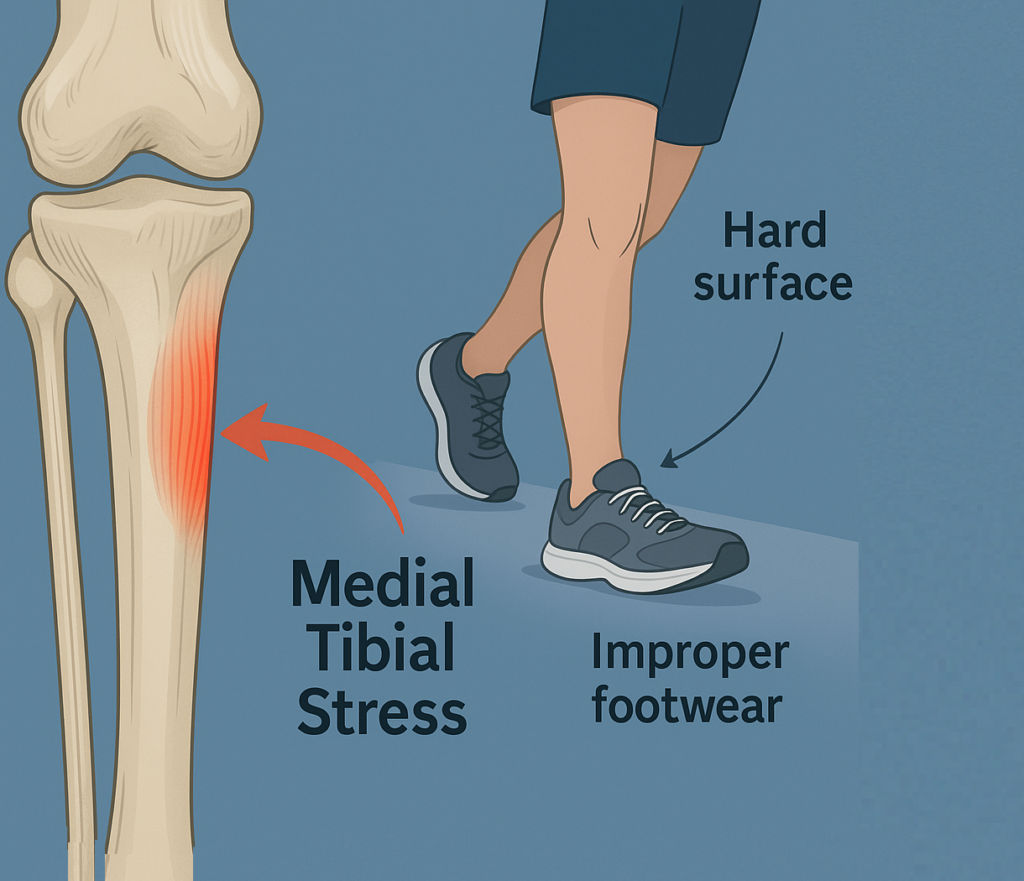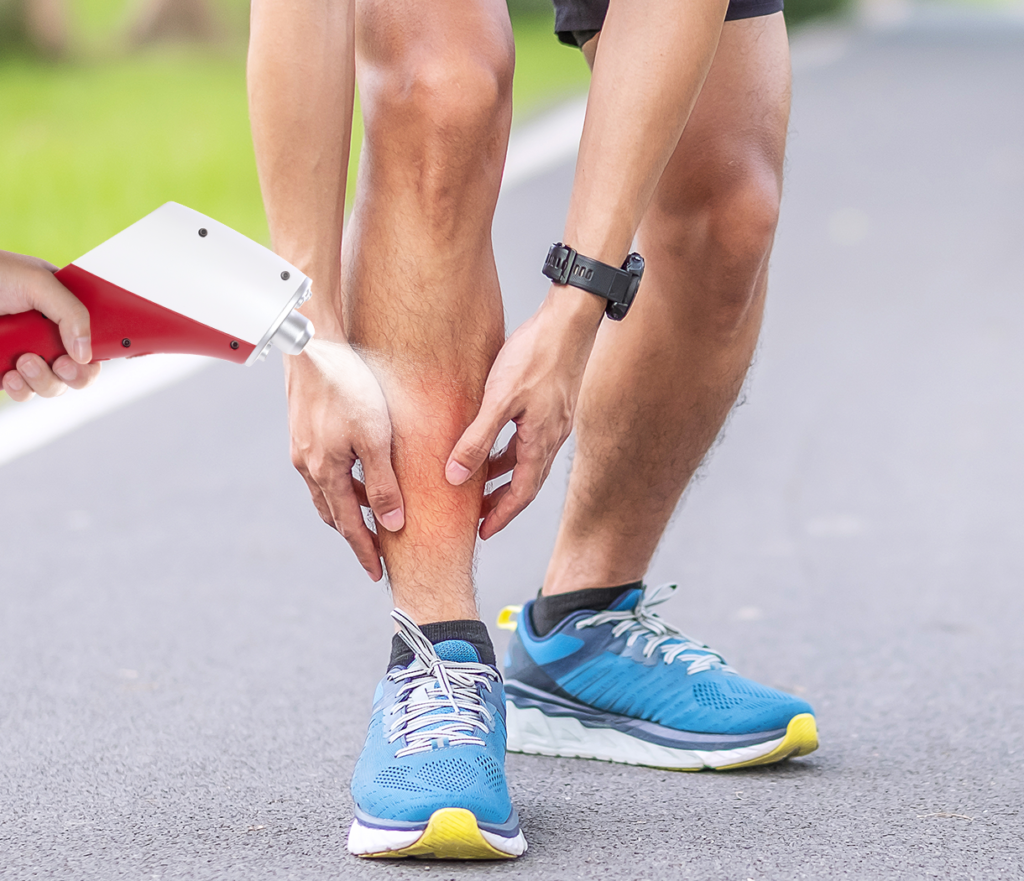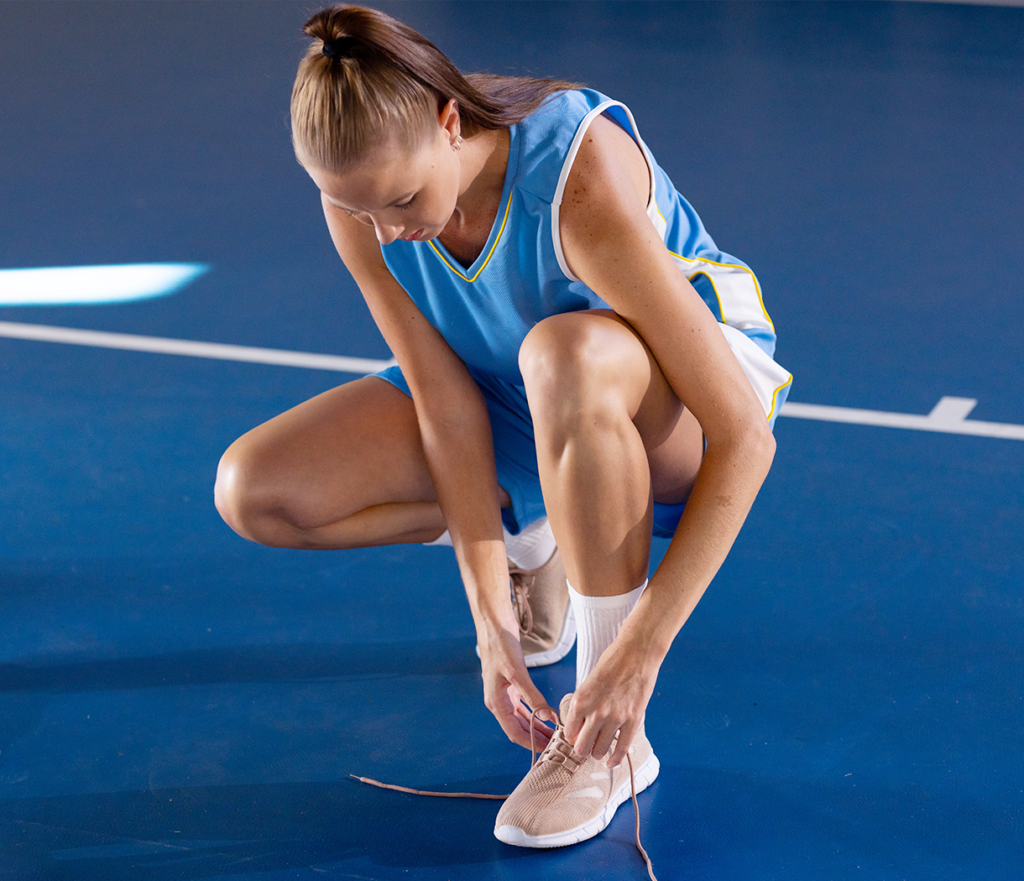Introducción
Shin splints represent one of the most frustrating and persistent injuries for athletes, runners, and active individuals. The sharp, throbbing pain along the tibia can sideline even the most dedicated athletes, often recurring despite traditional treatment approaches. As sports medicine continues to evolve, innovative treatment modalities are emerging to address the limitations of conventional therapies. Among these breakthrough technologies, CO₂ cryotherapy has shown remarkable promise in providing effective, long-lasting relief for shin splints while accelerating the healing process.
What Are Shin Splints?
Shin splints, medically known as medial tibial stress syndrome (MTSS), manifest as pain along the medial border of the tibia or shinbone. This condition involves inflammation of the periosteum, the thin membrane surrounding the bone, along with associated muscle and fascial tissue irritation. The pain typically presents as a dull ache that can progress to sharp, stabbing sensations during activity. Shin splints are common in athletes due to repetitive impact on the shin, affecting millions of active individuals annually. The condition can significantly impact athletic performance and daily activities if left untreated.
The Challenge of Treating Shin Splints
Traditional treatment approaches for shin splints often fall short of providing comprehensive, long-term relief. Conventional methods like the 20/20 rule for icing require frequent application and extended treatment periods, which can be inconvenient for active individuals. Many athletes find themselves caught in a cycle of temporary relief followed by symptom recurrence, particularly when returning to high-impact activities. The multifactorial nature of shin splints, involving biomechanical, inflammatory, and tissue damage components, requires a more sophisticated treatment approach that addresses all underlying mechanisms simultaneously.
Introducing CO₂ Cryotherapy as an Innovative Solution
CO₂ crioterapia represents a paradigm shift in shin splint treatment, offering precise, controlled cooling that penetrates deeper into tissue than traditional ice therapy. This advanced technology utilizes carbon dioxide gas at temperatures reaching -78°C, delivered through specialized applicators that ensure consistent thermal delivery. CO₂ cryotherapy delivers controlled cooling to reduce inflammation, accelerate muscle repair, and improve circulation, making it particularly effective for treating the complex pathophysiology of shin splints. The treatment’s rapid application time and targeted approach make it an attractive option for athletes seeking efficient recovery solutions.
What Causes Shin Splints? Key Factors and Risk Groups
Understanding the multifactorial etiology of shin splints is crucial for developing effective treatment strategies. The condition rarely results from a single cause but rather emerges from a complex interplay of biomechanical, environmental, and physiological factors that create the perfect storm for periosteal inflammation and tissue damage.

Overuse and Repetitive Stress Injuries
Overuse injuries represent the primary mechanism behind shin splint development, occurring when repetitive stress exceeds the tissue’s capacity for repair and adaptation. The tibialis posterior muscle, flexor digitorum longus, and soleus muscles generate significant traction forces on the periosteum during repetitive activities. Microtears in the periosteal attachments lead to inflammatory cascades that manifest as the characteristic pain and tenderness associated with shin splints. The cumulative stress from high-impact activities creates a chronic inflammatory state that perpetuates symptoms and delays healing. Without adequate recovery periods, these microscopic injuries compound, leading to more severe tissue damage and prolonged recovery times.
Muscle Imbalances and Biomechanical Issues
Biomechanical abnormalities and muscle imbalances significantly contribute to shin splint development by altering normal loading patterns on the lower leg. Excessive pronation, foot hypermobility, and inadequate arch support create abnormal stress distributions along the tibia. Weakness in the tibialis anterior muscle relative to the posterior compartment muscles leads to compensatory overactivity and increased periosteal stress. Hip abductor weakness and poor core stability can cascade down the kinetic chain, affecting lower leg mechanics and increasing shin splint risk. Leg length discrepancies and structural abnormalities further compound these biomechanical issues, creating asymmetrical loading patterns that predispose to injury.
Inadequate Footwear and Hard Training Surfaces
Environmental factors, particularly footwear and training surfaces, play crucial roles in shin splint development. Worn-out or inappropriate footwear fails to provide adequate shock absorption, transmitting excessive impact forces directly to the tibia and surrounding tissues. Hard training surfaces like concrete and asphalt amplify these forces, overwhelming the body’s natural shock absorption mechanisms. Inadequate midsole cushioning and poor heel-to-toe transition in athletic shoes contribute to inefficient gait mechanics and increased tissue stress. The combination of hard surfaces and suboptimal footwear creates a high-risk environment for repetitive stress injuries, particularly in high-volume training scenarios.
Who Is Most at Risk? (Runners, military recruits, dancers, etc.)
Certain populations face elevated shin splint risk due to their activity profiles and training demands. Distance runners, particularly those increasing mileage rapidly, represent the highest-risk group due to the repetitive nature of their sport and high training volumes. Military recruits undergoing basic training face unique challenges with sudden activity increases, often on hard surfaces while carrying additional weight. Dancers, especially those performing on hard studio floors, experience similar repetitive stress patterns with additional rotational and jumping movements. Basketball and soccer players encounter multidirectional forces and frequent direction changes that stress the lower leg tissues. Individuals with previous shin splint history, female athletes, and those with specific biomechanical profiles face increased susceptibility to recurrence.
Traditional Treatment Methods for Shin Splints and Their Drawbacks
Despite decades of clinical experience, conventional shin splint treatments often provide incomplete relief and fail to address the underlying pathophysiology comprehensively. Understanding these limitations helps explain why innovative approaches like CO₂ cryotherapy are becoming increasingly valuable in sports medicine practice.
Rest and Activity Modification
Rest and activity modification form the cornerstone of traditional shin splint management, but this approach presents significant challenges for active individuals. Complete rest may provide temporary symptom relief but fails to address underlying biomechanical issues or muscle imbalances that contributed to the injury. The deconditioning effects of prolonged inactivity can actually increase reinjury risk upon return to activity. Many athletes struggle with compliance due to competitive pressures or fitness maintenance concerns. The difficulty in determining optimal rest duration often leads to premature return to activity or unnecessarily prolonged recovery periods. Without concurrent treatment of contributing factors, rest alone rarely provides definitive resolution of shin splints.
Ice Therapy and Cold Compresses
Traditional ice therapy provides temporary symptom relief but has significant limitations in achieving therapeutic tissue temperatures and sustained effects. Conventional ice applications require 15-20 minutes of treatment, 3-4 times daily for several days, making compliance challenging for busy athletes. Ice packs and cold compresses fail to achieve consistent temperatures and often provide inadequate penetration to deeper tissues. The uneven cooling and potential for tissue damage from prolonged exposure limit treatment effectiveness. Rebound vasodilation following ice removal can actually increase inflammation in some cases, negating therapeutic benefits. The time-intensive nature of traditional ice therapy makes it impractical for athletes requiring rapid recovery between training sessions.
Nonsteroidal Anti-Inflammatory Drugs (NSAIDs)
NSAIDs provide symptomatic relief but come with significant side effects and may actually impair the natural healing process. While these medications can reduce pain and inflammation, they don’t address the underlying biomechanical or tissue damage issues causing shin splints. Prolonged NSAID use is associated with gastrointestinal complications, cardiovascular risks, and potential kidney dysfunction. Recent research suggests that NSAIDs may interfere with the normal inflammatory response necessary for tissue repair and remodeling. The masking of pain symptoms can lead to premature return to activity and increased injury severity. Many athletes prefer drug-free treatment options to avoid potential performance impacts and health risks.
Physical Therapy and Stretching Exercises
Physical therapy represents a more comprehensive approach but often requires extensive time commitments and may not address acute inflammatory components effectively. While stretching and strengthening exercises can address muscle imbalances and biomechanical issues, they typically provide slow, gradual improvements rather than rapid symptom relief. The lengthy rehabilitation process can be frustrating for athletes eager to return to competition. Exercise-based treatments may initially exacerbate symptoms if not properly progressed, leading to treatment setbacks. The complexity of prescribing appropriate exercise intensity and progression requires skilled professionals, limiting accessibility for some athletes. Without concurrent anti-inflammatory treatment, exercise therapy alone may be insufficient for complete recovery.
Why These Methods May Not Provide Long-Term Relief
The limitations of traditional treatments stem from their failure to address the multifactorial nature of shin splints comprehensively. Most conventional approaches target only single aspects of the condition, such as inflammation or biomechanics, rather than providing holistic treatment. The time-intensive nature of traditional therapies often conflicts with athletic training schedules and competitive demands. Incomplete resolution of inflammatory processes can lead to chronic symptoms and increased reinjury risk. The lack of precise, targeted treatment delivery limits the effectiveness of traditional modalities in reaching optimal therapeutic tissue temperatures. These shortcomings highlight the need for innovative treatment approaches that can provide rapid, comprehensive relief while addressing multiple pathophysiological mechanisms simultaneously.
What Is CO₂ Cryotherapy? Understanding the Technology and Its Mechanism
CO₂ cryotherapy represents a significant advancement in localized cooling technology, offering precise thermal control and enhanced therapeutic effects compared to conventional ice treatments. This innovative approach harnesses the unique properties of carbon dioxide to deliver consistent, controlled cooling that penetrates deeper into tissues while minimizing treatment time and maximizing therapeutic benefits.
Definition of CO₂ Cryotherapy and How It Works
CO₂ cryotherapy utilizes pressurized carbon dioxide gas released through specialized applicators to create rapid, controlled cooling of targeted tissues. The system operates by allowing pressurized CO₂ to expand rapidly through a precision nozzle, creating an immediate temperature drop to -78°C at the point of application. This controlled expansion follows the Joule-Thomson effect, where pressurized gas cooling occurs during rapid decompression. The technology provides consistent thermal delivery throughout the treatment duration, typically lasting 10-15 seconds per application site. The precise temperature control and uniform cooling pattern ensure optimal therapeutic effects while minimizing the risk of tissue damage associated with uncontrolled cooling methods.
Differences Between CO₂ Cryotherapy and Traditional Ice Therapy
CO₂ cryotherapy offers several distinct advantages over traditional ice therapy in terms of temperature consistency, penetration depth, and treatment efficiency. While conventional ice typically reaches temperatures of 0°C to 4°C, CO₂ cryotherapy achieves much lower temperatures of -78°C, providing more intensive cooling effects. The gas delivery system ensures uniform temperature distribution across the treatment area, eliminating the hot spots and uneven cooling common with ice packs. Treatment duration is significantly reduced from 15-20 minutes with traditional ice to 10-15 seconds with CO₂ cryotherapy, making it highly practical for busy athletes. The dry cooling method eliminates moisture-related skin irritation and provides more comfortable treatment experiences compared to wet ice applications.
How CO₂ Gas Cools Skin and Deep Tissue Quickly and Effectively
The rapid cooling effects of CO₂ cryotherapy result from the efficient heat transfer properties of carbon dioxide gas and the principles of controlled thermal shock. When pressurized CO₂ expands through the applicator nozzle, it creates an immediate temperature gradient that rapidly extracts heat from surface tissues. The gas’s superior heat transfer coefficient compared to air allows for more efficient thermal conductivity, enabling deeper tissue penetration. The controlled thermal shock creates rapid vasoconstriction, reducing blood flow to inflamed tissues and limiting secondary inflammatory responses. The brief but intense cooling stimulus triggers protective cellular responses that enhance tissue repair and regeneration processes.
Safety Profile and Non-Invasive Nature of CO₂ Cryotherapy
CO₂ cryotherapy demonstrates an excellent safety profile when administered by trained professionals using proper protocols and equipment. The controlled nature of the treatment allows for precise temperature and duration management, minimizing the risk of thermal injury. The non-invasive application method eliminates concerns about tissue penetration or systemic absorption associated with other treatments. The brief treatment duration reduces the risk of complications while maximizing therapeutic benefits. Cryotherapy is generally considered safe when performed by trained professionals, with minimal side effects reported in clinical studies. The technology’s built-in safety features and standardized protocols further enhance its safety profile for routine clinical use.

How CO₂ Cryotherapy Helps Treat Shin Splints
CO₂ cryotherapy addresses the complex pathophysiology of shin splints through multiple therapeutic mechanisms that work synergistically to provide comprehensive treatment. The technology’s ability to deliver precise, controlled cooling enables targeted intervention at the cellular level, addressing inflammation, pain, and tissue damage simultaneously.
Reducing Inflammation and Swelling in the Lower Leg
The anti-inflammatory effects of CO₂ cryotherapy represent one of its most significant therapeutic benefits for shin splint treatment. Cold-induced vasoconstriction reduces inflammation by limiting blood flow to affected tissues and decreasing metabolic enzymatic activity, effectively interrupting the inflammatory cascade. The rapid cooling creates immediate vasoconstriction, reducing capillary permeability and limiting inflammatory mediator release. This effect helps prevent the progression of acute inflammation to chronic inflammatory states that characterize persistent shin splints. The controlled thermal shock also reduces prostaglandin E2 production, a key mediator of pain and inflammation in musculoskeletal injuries.
Enhancing Blood Flow and Accelerating Muscle Recovery
Paradoxically, while CO₂ cryotherapy initially creates vasoconstriction, it subsequently triggers reactive hyperemia that enhances blood flow and accelerates healing processes. The alternating vasoconstriction and vasodilation create a “pumping” effect that improves circulation and enhances nutrient delivery to damaged tissues. CO₂ cryotherapy enhances immediate recovery of muscle function from neuromuscular fatigue, supporting faster return to normal function. The improved circulation facilitates the removal of metabolic waste products and inflammatory debris that can impede healing. Enhanced blood flow also delivers essential nutrients and oxygen required for tissue repair and regeneration processes.
Providing Pain Relief Through Analgesic Effects
CO₂ cryotherapy provides immediate and sustained pain relief through multiple neurological mechanisms that address both acute and chronic pain components. The intense cooling creates temporary neural blockade by slowing nerve conduction velocity and raising pain thresholds. Cold temperatures trigger physiological responses that relieve pain, muscle spasms, and overuse symptoms, providing comprehensive symptom management. The treatment stimulates the release of endorphins and other natural pain-relieving compounds through the gate control theory mechanism. The rapid onset of analgesia allows for immediate functional improvement and enables patients to engage in therapeutic activities more effectively.
Supporting Tissue Repair and Preventing Recurrence
The controlled thermal stimulus of CO₂ cryotherapy activates cellular repair mechanisms that support long-term tissue healing and injury prevention. The treatment stimulates fibroblast activity and collagen synthesis, promoting stronger, more resilient tissue formation. Cryotherapy reduces inflammatory response without altering muscle regeneration processes, ensuring that natural healing mechanisms remain intact. The enhanced tissue quality and improved biomechanical properties reduce the risk of reinjury and recurrence. The treatment’s ability to address both acute symptoms and underlying tissue pathology makes it particularly valuable for comprehensive shin splint management.
Clinical Evidence Supporting CO₂ Cryotherapy for Muscle Injuries
Growing clinical evidence supports the efficacy of CO₂ cryotherapy for various musculoskeletal conditions, including overuse injuries like shin splints. Research has shown that cryotherapy can significantly reduce muscle soreness and enhance recovery after intense physical activity, with sports medicine professionals increasingly recommending it for injury management. Studies demonstrate measurable improvements in pain scores, functional capacity, and return-to-activity timelines following CO₂ cryotherapy treatment. The technology’s ability to provide consistent, reproducible results makes it valuable for evidence-based treatment protocols. Ongoing research continues to refine optimal treatment parameters and expand the understanding of CO₂ cryotherapy’s therapeutic mechanisms.
Who Should Consider CO₂ Cryotherapy for Shin Splints?
CO₂ cryotherapy offers significant benefits for a wide range of individuals suffering from shin splints, but proper candidate selection ensures optimal treatment outcomes and safety. Understanding the ideal patient profile, contraindications, and precautions helps healthcare providers make informed treatment decisions.
Ideal Candidates: Athletes, Runners, and Active Individuals
Active individuals who require rapid recovery and minimal downtime represent ideal candidates for CO₂ cryotherapy treatment. Competitive athletes facing time constraints and performance pressures benefit significantly from the treatment’s rapid application and immediate effects. Distance runners experiencing recurrent shin splints find particular value in the technology’s ability to address both acute symptoms and underlying inflammatory processes. Military personnel and tactical athletes who cannot afford extended recovery periods benefit from the treatment’s efficiency and effectiveness. Weekend warriors and recreational athletes seeking professional-grade treatment options can access advanced therapeutic benefits previously available only to elite athletes.
Precautions and Contraindications
Certain medical conditions and individual characteristics may contraindicate CO₂ cryotherapy treatment or require special precautions. Individuals with peripheral vascular disease, Raynaud’s phenomenon, or other circulatory disorders may experience exaggerated responses to cold therapy. Cold urticaria, cryoglobulinemia, and other cold-related hypersensitivity conditions represent absolute contraindications to treatment. Patients with decreased sensation due to neuropathy or diabetes require careful assessment and monitoring during treatment. Individuals with a history of frostbite or abnormal cold responses should undergo thorough evaluation before treatment initiation. Pregnancy and certain autoimmune conditions may require modified treatment protocols or alternative therapeutic approaches.
When to Consult a Healthcare Professional Before Treatment
Professional medical evaluation is essential before initiating CO₂ cryotherapy, particularly for individuals with complex medical histories or severe symptoms. Persistent shin splint symptoms lasting longer than 2-3 weeks despite conservative treatment warrant professional assessment to rule out stress fractures or other serious conditions. Individuals with multiple medical conditions or those taking medications that affect circulation or wound healing should receive medical clearance before treatment. First-time users of cryotherapy should undergo professional evaluation to establish baseline health status and identify potential risk factors. Healthcare providers can develop individualized treatment protocols that maximize benefits while minimizing risks based on patient-specific factors.
Complementary Strategies to Enhance Shin Splints Recovery
While CO₂ cryotherapy provides significant therapeutic benefits for shin splints, combining it with complementary strategies creates a comprehensive treatment approach that addresses all contributing factors. This multimodal approach maximizes recovery potential and reduces the risk of recurrence.
Importance of Proper Footwear and Orthotics
Appropriate footwear and orthotic support play crucial roles in shin splint prevention and recovery by addressing biomechanical abnormalities and reducing tissue stress. Motion control shoes for overpronators and cushioned shoes for supinators help normalize foot mechanics and reduce periosteal stress. Custom orthotics can address specific biomechanical issues such as leg length discrepancies, arch abnormalities, and abnormal pressure distributions. The combination of proper footwear and CO₂ cryotherapy creates synergistic effects, with reduced biomechanical stress enhancing the anti-inflammatory benefits of the treatment. Regular footwear assessment and replacement ensure continued protection against recurrence as shoes lose their shock-absorbing properties over time.
Gradual Training Increase and Avoiding Overuse
Systematic training progression represents a fundamental component of shin splint prevention and management that complements the healing benefits of CO₂ cryotherapy. The 10% rule for weekly mileage increases helps prevent overuse injuries while allowing continued fitness development. Periodization of training intensity and volume provides adequate recovery periods for tissue adaptation and repair. Cross-training activities such as swimming, cycling, and elliptical training maintain cardiovascular fitness while reducing impact stress on healing tissues. The enhanced recovery provided by CO₂ cryotherapy allows for more aggressive training progression once acute symptoms resolve, but should be balanced with conservative load management principles.
Stretching and Strengthening Exercises for Lower Leg Muscles
Targeted exercise programs addressing muscle imbalances and flexibility deficits work synergistically with CO₂ cryotherapy to provide comprehensive shin splint management. Eccentric strengthening exercises for the tibialis anterior help balance posterior muscle dominance and reduce periosteal stress. Calf stretching programs targeting both gastrocnemius and soleus muscles improve ankle dorsiflexion and reduce compensatory biomechanical patterns. Hip strengthening exercises addressing gluteus medius weakness help normalize lower extremity mechanics and reduce shin splint risk. The anti-inflammatory effects of CO₂ cryotherapy enable more comfortable and effective exercise participation, enhancing the overall therapeutic response.
Combining CO₂ Cryotherapy with Physical Therapy for Optimal Results
The integration of CO₂ cryotherapy with comprehensive physical therapy programs creates optimal treatment outcomes by addressing both symptoms and underlying causes simultaneously. Pre-treatment cryotherapy reduces pain and inflammation, enabling more effective therapeutic exercise participation and manual therapy techniques. Post-exercise cryotherapy sessions help manage inflammatory responses and accelerate recovery between treatment sessions. The combination approach allows for more aggressive rehabilitation protocols while maintaining patient comfort and safety. Physical therapists can time cryotherapy applications to maximize therapeutic benefits and minimize treatment-related discomfort, creating positive feedback loops that enhance overall treatment compliance and outcomes.

Conclusion: Taking the Next Step Toward Shin Splints Relief
The evolution of shin splint treatment has reached a pivotal moment with the introduction of CO₂ cryotherapy technology. This innovative approach addresses the fundamental limitations of traditional treatments while providing rapid, effective relief for athletes and active individuals worldwide.
Recap of CO₂ Cryotherapy Benefits for Shin Splints
CO₂ cryotherapy represents a paradigm shift in shin splint management, offering comprehensive therapeutic benefits that address multiple pathophysiological mechanisms simultaneously. The technology’s ability to deliver precise, controlled cooling at -78°C for 10-15 seconds provides immediate anti-inflammatory effects while triggering beneficial cellular responses. The treatment’s rapid application time and immediate effects make it ideal for busy athletes and active individuals seeking efficient recovery solutions. The non-invasive nature and excellent safety profile ensure that patients can receive professional-grade treatment without concerns about adverse effects or prolonged recovery periods. The synergistic effects of inflammation reduction, pain relief, and enhanced tissue repair create optimal conditions for rapid healing and return to activity.
Encouragement to Incorporate Cryotherapy into Recovery Plans
The integration of CO₂ cryotherapy into comprehensive shin splint management plans represents a logical progression in sports medicine practice. Cryotherapy’s effects on the nervous system and neurotransmitters may help prime athletes for enhanced performance, providing benefits beyond injury treatment. The technology’s versatility allows for use in both acute injury management and preventive maintenance protocols. Healthcare providers and athletes should consider CO₂ cryotherapy as part of a multimodal approach that includes proper biomechanical assessment, training modification, and appropriate rehabilitation exercises. The investment in advanced treatment technology pays dividends through reduced injury recurrence, faster recovery times, and improved athletic performance. Athletes who incorporate CO₂ cryotherapy into their recovery routines often experience enhanced training consistency and reduced injury-related disruptions to their competitive schedules.
Preguntas más frecuentes (FAQ)
Not quite. While both use cold to reduce pain, CO₂ cryotherapy penetrates deeper, acts faster, and triggers a vasodilation–vasoconstriction cycle that traditional ice can’t match.
Many users feel reduced pain and tightness immediately. However, it’s best to follow a gradual return protocol based on your therapist’s guidance.
It does both. By improving circulation and reducing micro-inflammation, it supports muscle resilience and tissue healing, which may lower recurrence risk.
When administered professionally, the risk is extremely low. CO₂ cryotherapy is controlled and brief, unlike direct ice-to-skin methods which can cause harm.
Unlike surface-level treatments, CO₂ cryotherapy reaches deeper tissue layers and boosts microcirculation, tackling inflammation at its core rather than masking symptoms.
Yes, chronic cases may still benefit. Long-standing inflammation or scar tissue often responds well to cold-based vasomodulation and the improved cellular recovery environment CO₂ therapy creates.



